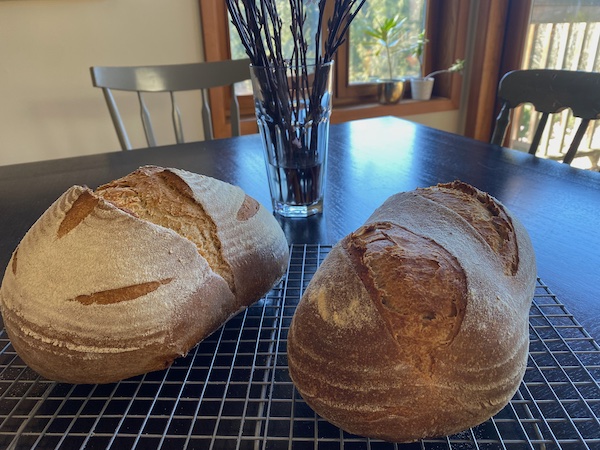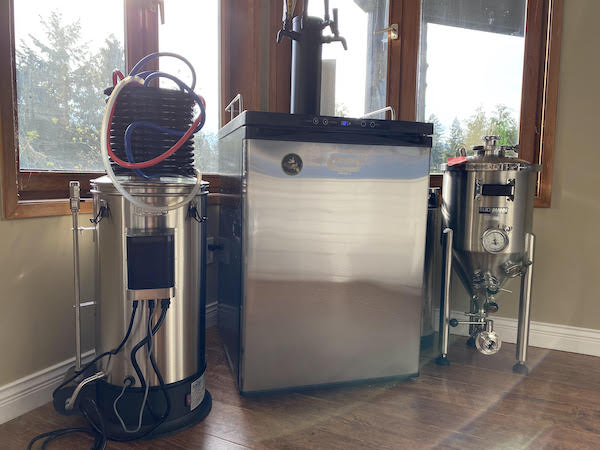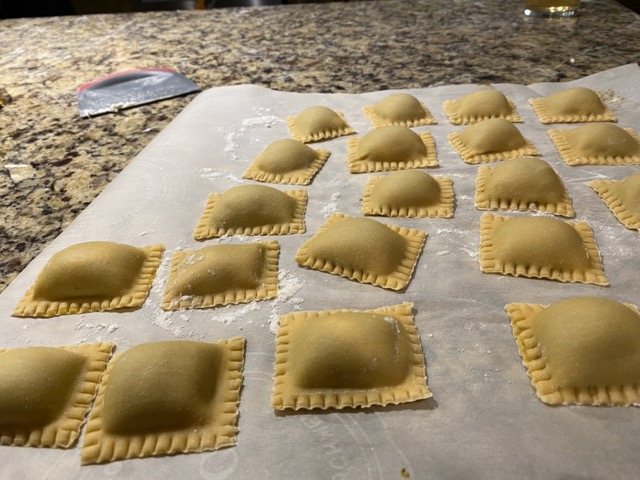Weekday Sourdough Bread
A weekday sourdough bread recipe that follows roughly the same schedule as a yeasted loaf except for an overnight preferment.
 A weekday sourdough bread recipe that follows the same schedule as my daily yeasted loaf except for an overnight preferment. The preferment is important for yeast vigor and taste. Because the dough isn’t left to ferment a long time at cold temperatures, the sourness is subdued and “rustic” might be a more appropriate descriptor. The recipe is dead simple to make during the week, it just assumes you already have a healthy sourdough starter.
A weekday sourdough bread recipe that follows the same schedule as my daily yeasted loaf except for an overnight preferment. The preferment is important for yeast vigor and taste. Because the dough isn’t left to ferment a long time at cold temperatures, the sourness is subdued and “rustic” might be a more appropriate descriptor. The recipe is dead simple to make during the week, it just assumes you already have a healthy sourdough starter.
Ale Tales - American Pale Ale
American Pale Ale. Malts: Canadian 2-row, Canadian Pilsner, Munich. Hops: Columbus (0.25oz), Vic Secret (1oz), Mosaic (1oz), Vic Secret (1oz), Mosaic (1oz). Yeast: SafAle US-05.
This is the second beer on my journey to finding a house American Pale Ale. What I’m looking for in an APA is a beer that first pleases my eyes and nose; for me that means a clear golden to copper colored beer, nice tight white head, and mostly floral and tropical fruit notes on the nose. Though I like tropical fruit, I explicitly steer clear of hazy or “juicy” style beers. The second requirement for an APA is that I can drink four pints and wake up relatively coherent. As far as taste goes, I’m looking for a firm bitterness but mellow floral, piney, and stone fruit notes throughout.
Practice Makes Perfect - Hopefully
Analyzing my short game statistics including putting and chipping to understand my golf game and how to get better.
I’ve determined that I need to practice around the greens if I’m to consistently shoot in the 70s. A couple of statistics gathered from The Grint confirmed my suspicions as I haven’t made a single putt outside of 5ft in three rounds. According to The Grint, from 5ft I only make 50% of my putts. To confirm I spent about an hour on the putting green testing myself from 6ft and the results were depressing. Giving myself the same shot 18 times (lining up as if I were playing) I only managed to make 61% of the putts, suggesting I am unable to put a ball on its intended line. I then tested myself from the same distance uphill left-to-right making 50%, and right to left only making 22% of putts! Going downhill from the same distance I could barely make anything, with only 11% of downhill left-to-right putts dropping for me and 17% of right to left putts dropping for me.
Our Daily Bread Updated
Update to a simple every day bread recipe. Ingredients: whole wheat flour, white flour, olive oil, water, salt, yeast.
 I’m updating my daily bread recipe as it has drifted a bit over the past year. The changes I recently made were minor but significantly improve the loaf appearance. Since sometime last year, I’ve increased the baking temperature to 475F to darken the loaf. I’m much happier with the look of the loaf now, especially the burning around the ear. I’ve also doubled the amount of olive oil to half a cup. The reason for that change is simple: I think it tastes better.
I’m updating my daily bread recipe as it has drifted a bit over the past year. The changes I recently made were minor but significantly improve the loaf appearance. Since sometime last year, I’ve increased the baking temperature to 475F to darken the loaf. I’m much happier with the look of the loaf now, especially the burning around the ear. I’ve also doubled the amount of olive oil to half a cup. The reason for that change is simple: I think it tastes better.
Ale Tales - Festbier
Festbier. Malts: German Pilsner, Munich, Carapils. Hops: Hallertau (0.75oz), Hallertau (1oz). Yeast: SafLager W-34/70.
 All I want to drink are lagers, but good german style lagers are hard to come by in Vancouver. So, taking matters into my own hands I’ve started a journey to create a festbier. This recipe is beginning life as something between a marzen and munich lager. The intention is to let it drift over time, most likely however it will end life pretty close to a modern festbier: golden in color, 5.5% alcohol, and a moderately bright hop flavor. I’m aiming for something highly drinkable, low in alcohol, and easy on the hops.
All I want to drink are lagers, but good german style lagers are hard to come by in Vancouver. So, taking matters into my own hands I’ve started a journey to create a festbier. This recipe is beginning life as something between a marzen and munich lager. The intention is to let it drift over time, most likely however it will end life pretty close to a modern festbier: golden in color, 5.5% alcohol, and a moderately bright hop flavor. I’m aiming for something highly drinkable, low in alcohol, and easy on the hops.
Brew Day Standard Operating Procedures
I recently began utilizing standard operating procedures for my brew day: step-by-step instructions of everything I need to do on brew day from setting up and filling my kettle to cleaning it and putting it away.
I recently began utilizing standard operating procedures for my brew day: step-by-step instructions of everything I need to do on brew day from setting up and filling my kettle to cleaning it and putting it away. I recently started this practice after forgetting to treat my sparge water. While not a critical step to the brew day, it nonetheless highlighted that left to own devices I will inevitably forget steps. Apart from fixing my forgetfulness, having a written set of instructions has had two unexpected but welcome side effects: first, by having the mundane written down my mind is free to focus or wander as it pleases and second, it has sped up my brew day considerably.
Grainfather - Lessons Learned
This post documents a couple problems I've had with the Grainfather. I also document my attempts to overcome those problems.
This post documents a couple problems I’ve had with the Grainfather. I also document my attempts to overcome those problems. To be clear, the Grainfather is a slick homebrewing appliance that automates away a lot of the mundane work of brewing. I absolutely recommend one if you have some extra cash burning a hole in your wallet. It does come with its own sets of quirks though and these two are the primary quirks causing me most grief.
Back to Homebrewing
I have rekindled my love for homebrewing. I'm once again back in a house with space and I have room for all the toys and necessary equipment.
 I have rekindled my love for homebrewing. I’m once again back in a house with space and I have room for all the toys and necessary equipment. In my giddiness I couldn’t help myself and purchased all new brewing equipment. As is common with hobbies I went completely overboard and upon receiving this last month’s credit card bill I felt a tad guilty. However, after a brew day under my belt and my first keg of Founders Breakfast Stout clone kegged and carbonated, I feel vindicated in my irresponsible purchase decisions. This post will simply highlight the new brewing setup. As I learn more about the equipment I’ll go deeper into likes and dislikes.
I have rekindled my love for homebrewing. I’m once again back in a house with space and I have room for all the toys and necessary equipment. In my giddiness I couldn’t help myself and purchased all new brewing equipment. As is common with hobbies I went completely overboard and upon receiving this last month’s credit card bill I felt a tad guilty. However, after a brew day under my belt and my first keg of Founders Breakfast Stout clone kegged and carbonated, I feel vindicated in my irresponsible purchase decisions. This post will simply highlight the new brewing setup. As I learn more about the equipment I’ll go deeper into likes and dislikes.
I Aged Myself Out of Software Development
2021 will mark the year I aged myself out of software engineering roles. About a month ago, on a Sunday, during an on-call shift, I considered a priority I told myself was unacceptable: staying home during an on-call instead of taking my kids to their activities.
2021 will mark the year I aged myself out of software engineering roles. About a month ago, on a Sunday, during an on-call shift, I considered a priority I told myself was unacceptable: staying home during an on-call instead of taking my kids to their activities. Had I stayed home instead of taking my kids out, I would have sent my resignation letter the next day. I told myself I would. Instead, I took my kids to their activities. The experience, however, made it evident that I can no longer work as a software developer with an on-call rotation.
Weekend Ravioli
 I recently became addicted to making ravioli. My kids love butternut squash and mushroom ravioli and campaign for both every week. It only recently occurred to me that making ravioli was straight forward and if you ignore most of the disciplines of baking it is similar to making bread. This is my weekend ravioli recipe. I call it my weekend ravioli recipe because it takes a bit of time to make and is a bit of a mess. That said you can get your kids involved and the process itself can be entertaining. This recipe makes about 60 ravioli. Whatever you don’t eat can be frozen for the following week. Do yourself a favor and get a bench knife for this. It makes cutting, moving, and shaping the ravioli a lot easier.
I recently became addicted to making ravioli. My kids love butternut squash and mushroom ravioli and campaign for both every week. It only recently occurred to me that making ravioli was straight forward and if you ignore most of the disciplines of baking it is similar to making bread. This is my weekend ravioli recipe. I call it my weekend ravioli recipe because it takes a bit of time to make and is a bit of a mess. That said you can get your kids involved and the process itself can be entertaining. This recipe makes about 60 ravioli. Whatever you don’t eat can be frozen for the following week. Do yourself a favor and get a bench knife for this. It makes cutting, moving, and shaping the ravioli a lot easier.